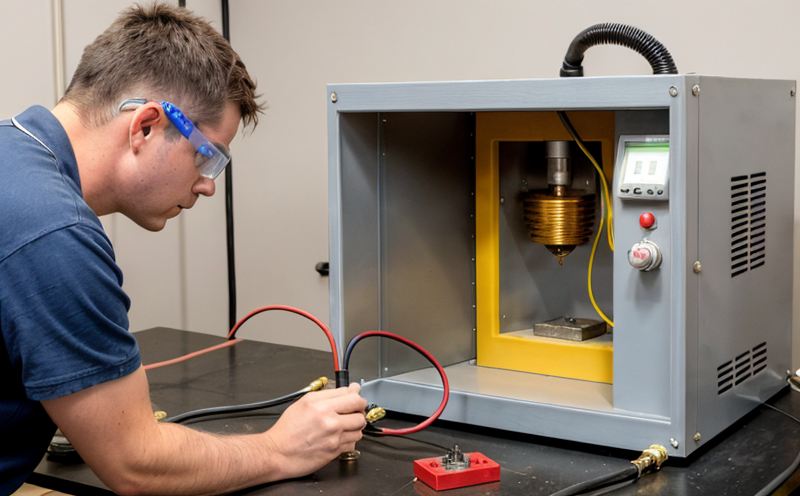ISO 205 Conductivity Testing by Eddy Current Method
The ISO 205 standard outlines a method for determining the electrical conductivity of metallic materials using the eddy current testing technique. This service is particularly useful in metallurgy and material testing, where understanding the electrical properties of metals is critical for quality assurance, compliance with international standards, and ensuring product reliability.
Electrical conductivity plays a crucial role in assessing the performance characteristics of metals, especially in industries such as aerospace, automotive, electronics, and construction. It helps identify potential flaws or inconsistencies that could affect the material's performance under various conditions. Conductivity testing by eddy current method is non-destructive, making it suitable for inspecting finished products without compromising their integrity.
The test involves passing an alternating electrical current through a coil placed near the surface of the metal specimen. The resulting magnetic field induces eddy currents within the material. Changes in these currents provide information about the conductivity and any anomalies present. This method is highly sensitive, capable of detecting very small variations in conductivity, which can indicate internal defects or differences in composition.
For accurate results, proper sample preparation is essential. The specimens should be clean, free from contamination, and representative of the production batch they are intended to represent. The testing environment must also meet specific requirements to ensure consistent and reliable measurements.
The eddy current method has several advantages over other conductivity testing techniques, including its ability to perform tests quickly and in real-time. It can provide detailed information about the entire cross-section of a component or material, making it ideal for quality control processes where rapid decision-making is necessary.
Compliance with ISO 205 ensures that the test results are consistent across different laboratories and jurisdictions. This standardization is vital for maintaining international trade standards and ensuring that products meet the required specifications in various markets.
Scope and Methodology
| Parameter | Description |
|---|---|
| Test Principle | The eddy current testing method relies on the interaction between an alternating magnetic field and a conductor to induce electrical currents. |
| Testing Equipment | Instruments include probes, coils, signal generators, and data acquisition systems. The equipment must meet specific accuracy requirements as defined in ISO 205. |
| Samples | Specimens should be clean and representative of the production batch. They may need to undergo preliminary treatments such as cleaning or conditioning before testing. |
| Data Analysis | The eddy current signals are analyzed to determine changes in conductivity. This involves comparing test results against baseline data for the material type. |
Testing is conducted under controlled conditions, ensuring that environmental factors do not interfere with accurate measurements. The process includes setting up the testing equipment according to ISO 205 specifications and calibrating it before each session to ensure precision. Once prepared, the specimens are placed in the coil, and the eddy current signals are recorded.
Analysis of these signals involves comparing them against baseline data for the material type. This comparison helps identify any deviations from expected conductivity levels, which can indicate internal defects or inconsistencies in the production process. The results are reported according to ISO 205 guidelines, providing clear and concise information about the tested sample's electrical properties.
Customer Impact and Satisfaction
The ISO 205 conductivity testing by eddy current method significantly impacts customer satisfaction in several ways. Firstly, it ensures that products meet the highest quality standards, which is critical for industries reliant on metal components. By adhering to this international standard, manufacturers can demonstrate compliance with regulatory requirements and enhance their reputation.
Secondly, the non-destructive nature of this testing method allows for real-time inspection without damaging the product. This capability enhances production efficiency, as it enables continuous quality control throughout the manufacturing process. Customers appreciate this feature because it reduces downtime and operational costs associated with rework or scrap.
Thirdly, the detailed insights provided by ISO 205 conductivity testing contribute to improved product reliability. By identifying potential issues early in the production cycle, manufacturers can address them promptly, ensuring that only reliable products reach the market. This proactive approach boosts customer confidence and satisfaction, as they receive high-quality products that perform consistently under various conditions.
Finally, the standardization of this testing method across different laboratories ensures consistent results globally. This consistency is essential for international trade, as it allows customers to trust the quality of imported materials without undergoing additional inspections or tests. The reliability and accuracy of these tests contribute directly to customer satisfaction and long-term business relationships.
International Acceptance and Recognition
The ISO 205 conductivity testing by eddy current method is widely recognized and accepted across various industries. Its international acceptance stems from its alignment with global standards, ensuring consistent and reliable results regardless of the laboratory location or jurisdiction.
This standardization is particularly beneficial for multinational corporations operating in multiple countries, as it simplifies quality assurance processes and facilitates compliance with local regulations. By adhering to ISO 205, companies can ensure that their products meet international standards, enhancing market access and customer trust.
The widespread adoption of this testing method also contributes to its credibility within the industry. Laboratories certified in performing ISO 205 conductivity tests are trusted by customers worldwide, as they provide accurate and reliable data. This reputation fosters long-term business relationships and enhances brand perception.
Furthermore, compliance with ISO 205 is often a prerequisite for certification and accreditation in various sectors. Industries such as aerospace, automotive, and electronics prioritize the use of this testing method due to its precision and repeatability. By leveraging this standard, companies can maintain their competitive edge and meet the stringent requirements set by industry leaders.





